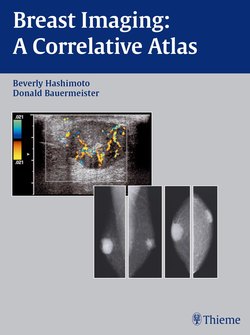Читать книгу Breast Imaging - Beverly Hashimoto - Страница 24
На сайте Литреса книга снята с продажи.
ОглавлениеCase 10
Case History
A 51-year-old woman presents for screening mammogram.
Physical Examination
• normal exam
Mammogram
Mass (Fig. 10–1)
• margin: circumscribed
• shape: oval
• density: equal density
Figure 10–1. In the upper inner quadrant of the right breast, there are two dominant well-defined oval masses. (A). Right MLO mammogram. (B). Right CC mammogram.
Ultrasound
Frequency
• 11.5 MHz
Mass
• margin: well defined
• echogenicity: anechoic
• retrotumoral acoustic appearance: increased acoustic transmission
• shape: ellipsoid (Fig. 10–2)
Figure 10–2. Right transverse breast sonogram: The two Mammographic masses correspond to two cysts. The fluid collections are anechoic; have well-defined, thin, hyperechoic walls; and have increased acoustic transmission.
Pathology
• cysts
Management
• BI-RADS Assessment Category 2, benign finding
Pearls and Pitfalls
Cysts are a component of fibrocystic change. This process has been identified clinically in about one third of women between 20 and 45 years of age. Autopsy studies have found about 54% of normal breasts have histologic evidence of cystic changes.
Suggested Readings
1. Frantz VX, Pickren JW, Melcher GE, et al. Incidence of chronic cystic disease in so called “normal breasts.” A study based on 225 postmortem examinations. Cancer 1951;4:762–783.
2. Jones BM, Bradbeber JW. The presentation and progress of macroscopic breast cysts. Br J Surg 1980;67:669–671.
3. Leis HP, Kwon CS. Fibrocystic disease of the breast. J Reprod Med 1979;22:291–296.
4. Leis HP Jr. Fibrocystic disease of the breast. J Med Assoc Alabama 1962;32:97–104.
5. Love SM, Gelman RS, Silen W. Fibrocystic “disease” of the breast—a non-disease. N Engl J Med 1982;307:1010–1014.
